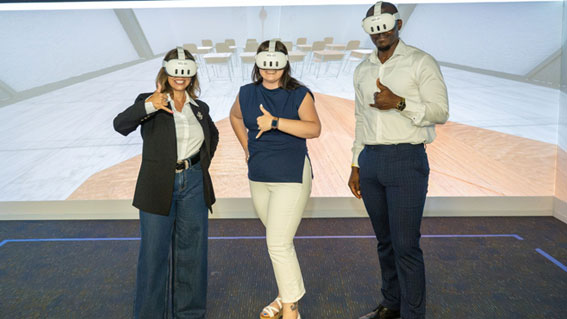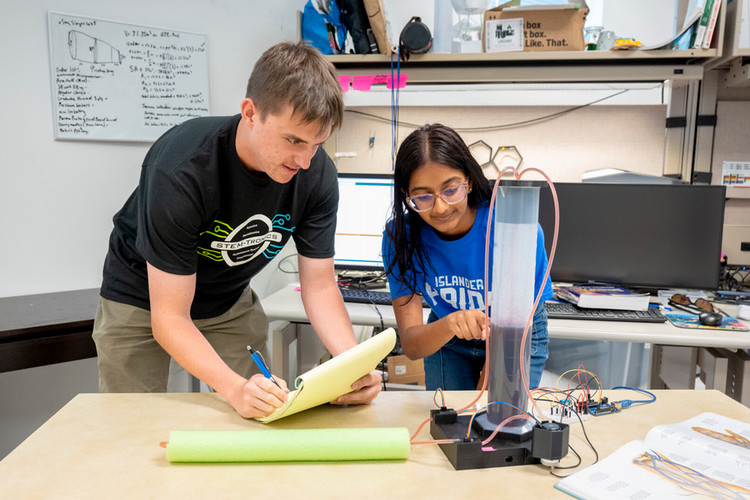New Research at TAMU-CC Aims to Identify Risk Factors of Osteoporosis
CORPUS CHRISTI, Texas – Dr. Frauke Seemann, Assistant Professor of Marine Biomedical Sciences at Texas A&M University-Corpus Christi, is focused on improving human health outcomes through her current research on Japanese Medaka, an East Asian fish living in rice paddies. By studying the effects of cross-generational inheritance of disease susceptibilities, Seemann is taking a deeper dive into the impacts of environmental stressors and their potential to cause debilitating diseases including osteoporosis, a medical condition in which bones lose density and strength.
“Deciphering the role of DNA methylation and histone marks in phenotype inheritance is imperative to address the health of the next generation,” Seemann said. “The long-term goal is preventive and therapeutic tool development to better assess, avert, and mitigate osteoporotic fracture risks, eventually reducing human bone disease susceptibilities.”
Through a newly earned $405,202 R15 Academic Research Enhancement Award (AREA) grant from the Department of Health and Human Services (HHS) National Institute of Environmental Health Sciences (NIEHS), Seemann will continue her study of Japanese Medaka and the effects of benzo[a]pryne (BaP) exposure to its offspring. Exposure to environmental stressors has repeatedly been associated with increased odds of developmental bone defects in offspring and are considered a risk factor for later life-stage osteoporosis.
“This study aligns closely with the NIEHS mandate to advance environmental health sciences through enhanced understanding of molecular pathways targeted by environmental pollutants,” Seemann said.
The World Health Organization considers osteoporosis the “silent epidemic of the 21st century,” rendering 50 million Americans more susceptible to osteoporotic fractures. Increasing evidence suggests that parental (preconception), in utero, and early life environments impact risk for bone fragility in adults. According to Seemann, Medaka make an excellent test subject as their spine and bone cell structure bare strong resemblance to that of humans. In addition, a unique benefit of using fish models is that it allows real-time live imaging of many biological traits, including skeletal development and repair.
“It has been shown that the sound type of gene expression, the function of the cells in bone formation, and bone resorption in this fish is very similar to what is happening in humans,” Seemann said.
Approaching the question how parental exposures affect offspring health, the project goals include the molecular characterization of distinct bone cell populations and bone development following BaP exposure to pinpoint critical developmental windows for later bone mineral density impairment in the offspring. Working alongside a well-trained cohort of Islander students, Seemann states the project will provide the groundwork for those hoping to pursue a career in biomedical sciences.
“This study, conducted at our Minority-Serving Institution, will expose students to cutting edge research and research methodologies,” Seemann said. “It will increase STEM participation and retention of underrepresented students, some of whom will no doubt pursue a career in biomedical science.”
The project, carried out in Seemann’s labs on the first and third floor of Island University’s Tidal Hall, is currently preparing for the first exposure experiment in the fall. The project is scheduled to have yearly updates with the NIEHS and wrap up in March 2024.
According to Dr. Ahmed Mahdy, TAMU-CC Vice President for Research and Innovation, Seemann’s research not only helps to elevate the prestige of the University but also to captivate the attention of researchers from around the globe.
“Dr. Seemann’s research is significant because we are utilizing our already existing strengths in marine biology to explore and grow our research in biomedical sciences,” Mahdy said. “This project creates an impact that will not only affect the population locally, but globally, which can drive the next generation of up-and-coming scientists to join our University, and that’s very exciting.”











